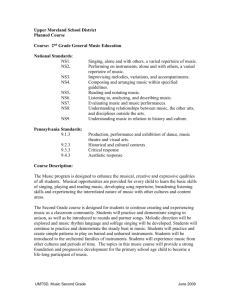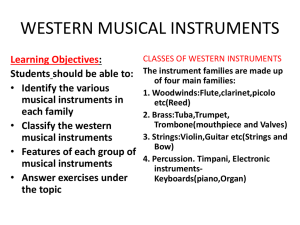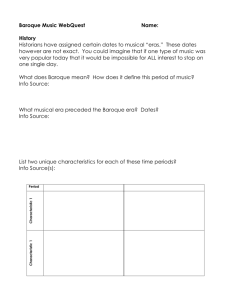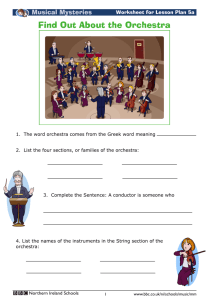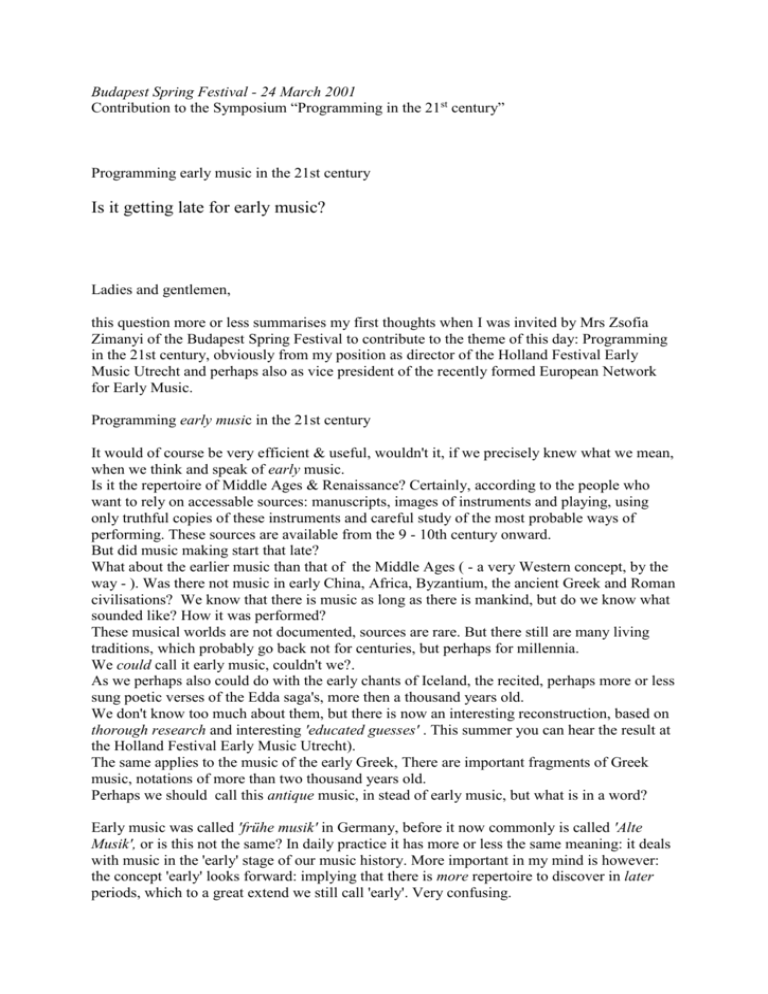
Budapest Spring Festival - 24 March 2001
Contribution to the Symposium “Programming in the 21st century”
Programming early music in the 21st century
Is it getting late for early music?
Ladies and gentlemen,
this question more or less summarises my first thoughts when I was invited by Mrs Zsofia
Zimanyi of the Budapest Spring Festival to contribute to the theme of this day: Programming
in the 21st century, obviously from my position as director of the Holland Festival Early
Music Utrecht and perhaps also as vice president of the recently formed European Network
for Early Music.
Programming early music in the 21st century
It would of course be very efficient & useful, wouldn't it, if we precisely knew what we mean,
when we think and speak of early music.
Is it the repertoire of Middle Ages & Renaissance? Certainly, according to the people who
want to rely on accessable sources: manuscripts, images of instruments and playing, using
only truthful copies of these instruments and careful study of the most probable ways of
performing. These sources are available from the 9 - 10th century onward.
But did music making start that late?
What about the earlier music than that of the Middle Ages ( - a very Western concept, by the
way - ). Was there not music in early China, Africa, Byzantium, the ancient Greek and Roman
civilisations? We know that there is music as long as there is mankind, but do we know what
sounded like? How it was performed?
These musical worlds are not documented, sources are rare. But there still are many living
traditions, which probably go back not for centuries, but perhaps for millennia.
We could call it early music, couldn't we?.
As we perhaps also could do with the early chants of Iceland, the recited, perhaps more or less
sung poetic verses of the Edda saga's, more then a thousand years old.
We don't know too much about them, but there is now an interesting reconstruction, based on
thorough research and interesting 'educated guesses' . This summer you can hear the result at
the Holland Festival Early Music Utrecht).
The same applies to the music of the early Greek, There are important fragments of Greek
music, notations of more than two thousand years old.
Perhaps we should call this antique music, in stead of early music, but what is in a word?
Early music was called 'frühe musik' in Germany, before it now commonly is called 'Alte
Musik', or is this not the same? In daily practice it has more or less the same meaning: it deals
with music in the 'early' stage of our music history. More important in my mind is however:
the concept 'early' looks forward: implying that there is more repertoire to discover in later
periods, which to a great extend we still call 'early'. Very confusing.
The French, the Dutch and now most Germans look at it in another way: they speak about
'musique ancienne', about 'oude muziek' and 'Alte Musik', as some English refer to: 'old
music'.
These concepts: 'Ancienne', 'Oud', 'Old', 'Alte'; they have a different perspective: backwards.
All this, I hope, is not merely a game of words. The way we talk about music of the past has
of course to do with the way we think about music of the past. It demonstrates our mental
frame of reference.
And the way we think about music of the past is changing in a very significant way.
Time changes and we change with it, is the classic dictum. This is also very true with the way
we relate ourselves to the music of the past.
Throughout music history, there is more and more history. But we also see history now
differently then some centuries ago.
Look to the Academy of Ancient Music. You might think of the well known British periodinstrument-orchestra, directed by Hogwood or Manze?
No, I'm thinking of a London society of musicians, founded in 1710. These musicians
decided to perform again masterpieces of the 16th century, music of composer who were
dead.. This was a totally new idea, because all music up untill then was contemporary music in fact a situation that lasted untill deep in the 19th century.
Music, for most of its own history, has always been contemporary music. It was made for the
taste of the day, like our popular music now. It was performed, and when successful,
performed again, perhaps elsewhere, but soon enough replaced by new work of the same and
other composers. Much was not in print - handwritten scores and copies were gradually
forgotten.
Of course there were the now well known occasional exceptions: Mozart made his own
arrangement of Handels Messiah, looking back for half a century or so and adding
instruments that didn't exist in Handels time, according to the taste of Mozarts own time.
Bach is the perfect example; many of his great works being reworked, arranged, even
transformed, time and again in the centuries after his death in 1750. Mozart, only a few
decennia later, occasionally used melodies of Bach in his own way, as Bach himself did with
existing song lines and useful fragments of composers before him.
The 19th century saw Mendelssohn performing a complete Bach work, the St. Matthew's
Passion, for the first time since Bach's own lifetime and in a 'modern' arrangement.
Gustav Mahler towards the end of that century reworked and largely re-instrumentated Bach
Orchestral Suite, while Leopold Stokowsky made his popular arrangements in the beginning
of the 20th century. When Edward Elgar did something similar in the 20-ies he motivated this
as follows: "I wanted to show how gorgeous and great and briljant he would have made
himself sound if he had our means". Today such a legitimation of a composer would be
inconceivable, but still the great works of our music history are - so to say - recycled and
transformed in the actual musical language.
Could we call that early music? Why not? In Utrecht we do. In our next festival we will show
how Franz Liszt dealt with Schuberts Winterreise and Berlioz' Symphonie Fantastique, both
performed on restaured grand piano's of his time. Not as an musical museum exhibition, but
as a contemporary performance, which appeals directly to a modern audience and makes of
living witness of the tonal beauty of a work in a performance on the instruments it originally
was meant for.
This shows how the 20th century brought something new. Instead of using the old notes in
contemporary way, a totally new perspective emerged: reconstructing the music, performing
in the way it must have been conceived with the same instruments of that time, or newly made
copies, according to the descriptions, fragments, and of course pictures in books, engravings
or paintings.
This approach originated in the beginning of the 20th century in England by the German
immigrant Dolmetsch family, It got its biggest boost in the Sixties and Seventees, when in
several countries in Europe and the USA, we see a growing interest in performing renaissance
music, first in amateur circles and later at a purely professional level, much stimulated by the
growing attention in conservatories like for instance in Basel, Amsterdam and The Hague.
You rightly could call this early music, for it focussed on the early repertoire: renaissance and
medieval.
But this movement produced two extremely important by-products that at the same time
expanded the meaning of early and brought it some relativety.
One was the consequence of going into the archives. Few of the Renaissance and early
baroque music had been published. And if scores in the past had been discovered and
published, it was certainly not with the improved knowledge and energy of the recent
generations of musicologists.
The Eightees and Ninetees produced an great amount of unknown pieces, much of them of
real interest, and therefore easily provoking the feeling that there was another world of
beautiful music to unlock. You just had to enter these treasure chambers and for many many
years to come we had an potential of hundreds and hundreds unknown masterpieces, all
second premieres, born again, kissed to life after a long and deep sleep of centuries, by hard
working musicologists and dedicated early music performers.
We indeed saw a astonishing expansion of the known and explored repertoire of bygone
times, in particular music of the first half of the last millennium .
There was a second, important by-product, that expanded the concept of early music and
made it a real 20th century concept.
Being faithful to the score and faithful to the instruments it was conceived for, and to a well
informed and considered performance style… Rapidly there was a growing awareness by both
musicians and audience that this particular mentality and attitude did not only apply to the
Renaissance and Early Baroque Repertoire, but also to the music of the Classical and
Romantic Period even up to the second half of the 19th century and even beyond.
More and more we did realise that there were forgotten and smuggled away negative sides of
the technical improvement of many musical instruments: most important being the
diminishing, even loss of tonal colouring and the disruption of balance in ensembles and
orchestras in terms of loudness.
We started to realise that the Mozart, Haydn, Beethoven we knew were were not 'the real
stuff' in the sense that the performing apparatus had little to do in size, sound and style with
the ensembles the composers worked with. The large size orchestras, and their technically
improved and louder instruments were at a far distance of conception of the composer.
In terms of the paintings of their time, we became aware that we looked at enlarged
photographs of the Leonardo's Mona Lisa and Rembrandt's Nightwatch, instead of enjoying
the structure and texture of the original paintings. To clarify what was happening in early
music, we discovered the parallels with the cleansed and restaured Renaissance and Baroque
paintings of Italy, who to every bodies surprise looked as new works of art, freshly paint.
We know by now, almost half a century later how this development not only accounted for a
new category of concerts, both in the chamber music and in the small orchestra format, but
also for a new audience.
It almost became an alternative circuit, literally, in different venues. Not the much to large
concert halls or mixed purpose cultural centers were suited for this early music, but churches,
open air spaces, castles, palaces, court yards and other public monuments.
This also lead to an alternative concert practice and gave room to a flourishing culture of
early music festivals, again in specific situations: abbayes, monasteries, or as is the case in
early music festival-cities like York, Regensburg and Utrecht with their absolutely raving
medieval city centers.
To a certain extend this alternative approach by musicians in alternative concert-situations
had also lead to an alternative audience-culture, which from the general classical audience
point of view we also could call: sub-culture.
If one seaks to characterize this subculture of early music lovers in positive terms, one easily
reckognizes the much more than average interest and love for a specific repertoire that one
finds here both on the performing and audience side. Our own audience surveys have shown
that we are dealing with a higher educated audience, from upper social layers, that knows
more than the average audience about music, and people who generally speaking come to
concerts better prepared and frequently have their opinion ready.
Perhaps this 'alternative' nature of the audience also accounts for another prominent feature:
the tendency to defend this early music approach in terms of justification, even in terms of
truth. The debate between the mainstream concert practice and the 'alternative' early music
approach not seldom became a debate between believers of different denominations.
One of the most notorious moments in Dutch music history was when –in the Sixties- Frans
Brüggen in a hot public debate declared that 'every note of Mozart the Concertgebouw
Orchestra is playing, is a lie'. This of course was a enormous exaggeration, which Frans
nowadays will modify and does not like to be reminded of; but in a way it gives a sharp sign
of the time.
Early music performance practice was in general not at all common practice and regarded as a
mature, justified, let alone respectful approach of the baroque and classical domain.
Again: only 30-40 years ago, to many it still was something alternative, even parochial, a
closed circuit of self affirmative believers, which had little to do with the mainstream concert
practice of regular symphony orchestra's, Steinway grand pianos, metal strings in the violin
family, wide born & polished brass instruments with valves and a symphony audience that is
fond of large scale events.
How different is the situation now. I speak in the first place of The Netherlands; well aware
of the fact that situation in different countries vary extremely. But of course I can speak best
of the circumstances I am familiar with, in particular since The Netherlands for many years
are considered abroad as the leading early music country.
If you look superficially, from the outside, the situation indeed is flourishing.
-
The national Top Ten of CD-sales every month includes several productions performed on
period instruments, sometimes even the majority. In Holland it is possible that Andreas
Scholl defeats Andrea Boccelli.
-
Last January it struck me that in Amsterdam – no festivaltime, just plain season - you
could in 5 days attend 4 high standard early music programs. In the Concertgebouw a
Haydn program by the Academy of Ancient Music with Hogwood and Cecilia Bartoli and
a Brahms program by Philippe Herreweghe and his Orchestre des Champs Elysées.
Two churches offered a very interesting medieval program and a classical program on
period wind instruments.
-
The last mentioned concert was part of the Early Music Concert Network which organises
every season some 120 concerts with international ensembles in 30 historic venues all
over the country. Apart from this, a couple of other organisers offer regionally and
locally an estimated further 60 to 80 concerts of professional level.
-
The Dutch Early Music Network is the work of the same organisation that is responsible
for the annual Holland Festival of Early Music Utrecht, where we present over 120
concerts in 10 days plus additional events such as an international symposium on a
specific aspect of historic performance and a International Early Music Market with some
70 instrument builders, publisher and other exhibitors.
-
Our organisation is subsidized nationally, regionally and locally, still over 1/3 of our
income comes from ticket sales. Its strength is also demonstrated by a supporting
Foundation of more than 5ooo friends who together donate 1/5 of the annual festival
budget.
So, you expect that programming in the 21st century is no big deal for an Early Music
Organisation with this background?
I wish it was that easy, but it isn't.
We must look beyond the immediate horizon and sense beneath the surface. Than we will
notice that there are important developments which will directly influence the presentation of
early music in the coming years.
Perhaps it it is more realistic not to speak of the 21st century, but of the next 21 years to
come. Most of what I have told before applies to the last 21 years, so this nicely balances my
position. And perhaps this 2 times 21 years in the end comes close to the real duration of the
high tide of early music in The Netherlands; the lifetime of a success story. I mean it!
Two years ago I was interviewed by the Dutch Arts Counsel, in the course of the application
procedure for a new subsidy period of 4 years. I was confronted with the following
interesting question: "If your Early Music Organisation were a person and had a human
lifespan, at what age do you think your organisation is now?"
Very good question (and a tricky one). I decided to be honest. The Utrecht festival in real
time then was 19 years old and my answer was: if the festival were a person, the age could be
around 40 years, just successfully surviving the midlife crises".
There were good reasons to say this, because we actually were in transition.
Started as a small festival with heavy emphasis on the real early repertoire from the 11th till
17th century , it rapidly had expanded to a 10 days event and, being in the forefront of the
international early music scene, we were eager to incorporate new trends, insights and
policies. This had brought new perspectives, such as early music from the non-western
cultures and in interest in neighbouring areas such as medieval storytelling. Furthermore we
showed more and more attention for composers of the 19th century.
Still it was felt by the board and also by important opinion leaders that, in order to survive in
the 21st century, the festival needed new impulses and a more open communication to the
musical environment.
One can - and in fact we have to - go on and on for years with discoveries in archives, but
we have to be sensitive to the fact that the notion of early music itself is shifting, as much as
the world of early performance practice has seen changes which radically will affect the
immediate future of early music practice, in Holland but gradually also in other European
countries.
- In the first place there is the shifting basic orientation I already referred to: from truthdriven to esthetics-driven. We have become to realise, much helped by the writings of
Richard Taruskin, that the historic performance approach of the late 20th century has no
absolute, that is to say no timeless value, but in fact is an expression of contemporary
esthetics. Realising this offers the basis for a new approach, where there is no pretention
to perform so-to-say 'historically authentic', but on the basis of modern historical
knowledge as well as the contemporary personal creativity of the performer. Authentic
performance practice thus became: H.I.P, historically informed performance practice. Not
a category, but a definition of approach in modern music making.
We now see a new tendency, were intuition may play its role again, next to knowledge.
First class 'regular' singers for instance, appear with period instrument orchestra's. They
are not early music specialists, but good singers who can work with the information of the
specialists. And this is not only the result of a commercial drive, where new angles have
to be found to cope with declining CD sales! Such phenomena also express a recent
change in professional attitude, were the criteria and categories are lived up to less
dogmatically and strict any more than in the past 21 years.
- The way to this was also paved by leading conductors who rose to their status as pure
early music champions, but also accepted to work with 'regular orchestra's' in order to
train their sensibility and skills in dealing with the baroque repertoire, which for the last
21 years was the almost exclusive territory of the period instrument ensembles. Look at
Harnoncourt, Koopman, Herreweghe, Goebel, Gardiner Hogwood and all the others who
started as purists and gradually became heroes on former ennemy territory. Perhaps one of
the results is also that the major orchestra's - many of whom have left much of the baroque
and classical repertoire for the last 21 years - now one by one dare to come back to it,
frequently under the baton of the well known (and well paid by the way) early music
heroes.
- There is also another side: major early music festivals like Utrecht can hardly afford any
longer the baroque orchestra's they have nurtured and seen grow up. Now these ensembles
in Holland are invited in the regular series of the main concert halls, substantially
sponsored by multinational companies who are less interested in sustaining early music
but much in famous names.
- This new popularity in main stream musical circles unfortunately has also some restrictive
effect on the repertoire: when these period instrument orchestras leave their homeland –
the early music circles, festivals and so on, repertoire concessions often are required.
Once they are invited to come back, these festivals no longer can meet the risen financial
standards. But to be honest, I don't mind too much. The role of especially festivals in my
opinion is to be in the forefront of developments, to present new views, new directions
and new generations.
- A word about these new generations. In Holland they are going to be differently educated.
In the country that has the best early music departments (The Hague, Amsterdam) we now
see new orientations. In Amsterdam there is no longer an early music department. You
now see the professor of modern flute communicate and work together with the professors
-
-
-
of traverso and recorder in one department. And students tend more to study both
instruments, in order to be able to master a broad repertoire. No doubt that tendencies like
these will influence the concert practice in immediate future. Instrumentalists will choose
the instrument with matches best the repertoire.
Their role model might be someone like Bart Scheemann, the much praised first oboe of
Valery Gergievs Rotterdam Philharmonic Orchestra, who choose completely for the
freedom of chamber music, also on baroque oboe. Depending on the repertoire, he now
records with both instruments.
I already touched the notion that musical practice is culturally defined by its own time.
The Netherlands are a multi cultural society, so there is music present from every corner
of the world. Dutch composers and performers are interested in the ideas of their
colleagues from China and Japan as much as from Siberia or Africa. The world has
become an open village to every one who has access to the internet. An airline ticket
Amsterdam-New York is cheaper than one to Vienna or Budapest.
It is therefore only natural that in our festival we are interested programs that deal with
our Western European musical traditions in relation to the rest of the world. That's why
we are interested in the by-effects of Western colonalisation, for instance the effect the
music the Jesuits exported to China and the New World. In the coming years we hope to
be able to explore the musical relations and influences of both sides of the Adriatic in the
14th and 15th century, later we will highlight the Greek-Orthodox versus Roman catholic
traditions.
But of course we shall not forget the ongoing exploration of hidden treasures in archives
and libraries all over Europe. Particularly in Italy there is now a booming musicological
research. Many times we then are confronted with large-scale projects which few festivals
can afford. In our flourishing economy we are confronted with declining budgets and
highly risen fees, also because of the professionalisation of our area.
This is one of the reasons why we see more efforts in the direction of co-productions, bilateral ventures and recently emerging networks in the area of early music.
Last year two early music networks have been established. One is an initiative of some
Central and Eastern-European smaller festivals. The other is a French initiative, in the
first place to join forces in obtaining funds of the European Union, but also to exchange
ideas, plan and projects. This European Early Music Network is I think a promising
development.
Now how does all this relate to our theme: programming in the 21st century? What about
programming early music in the next 21 years?
I have little doubt that there will be a future audience for specific-identity-festivals like ours.
These festivals are here to stay. And there will be concerts in churches, castles, by period
instrument ensembles, presenting exquisite programs, carefully researched, developed and
skilfully presented. This will be the case in Holland and elsewhere in Europe. There will be an
audience, even a growing audience I think for this type of concerts. They will probably
continue an ongoing line for at least another 21 years.
But we will also see more historic performances in regular concert-series of the big houses
and in the larger music and multi-discipline festivals when early music has come out of the
closet. These concerts will not necessarily labelled early music, perhaps just on historic
instruments or so.
What I wanted to emphasize is that in our changing society it is only natural that also the
notion of early music changes. I am convinced that after that we have realised in the last 21
years that early music is a contemporary music, we will gradually in the next 21 years see a
new transition, where the notion of early music becomes less important and we will
emphasize the knowledge, artistic skill and mentality with repertoire from every period will
be approached and performed.
Where in new generations there are musicians with historic awareness that are less single
minded and probably more inclined to switch from one instrument to the other, given the
repertoire.
We will need specialists and generalists in this approach. The huge advantage will be that
what we now call early music will be able to communicate better with the rest of society.
Early music started as a laboratory, more than a century ago. It developed perhaps into a
parochial ghetto where it fortunately also burst out. Now there is a chance to open up,
communicate and enrich a broader orientated musical performance landscape.
Perhaps it is getting a bit late now for the old fashioned early music now. But it certainly is
early enough to secure a rich future for a historically well informed and documented
performance practice open to the whole of Europe and beyond.
Thanks very much to the Budapest Spring Festival for the opportunity given to me to share
some of my thoughs with you and thank you for your attention.
Casper Vogel
Director Holland Festival Early Music Utrecht
All rights reserved - No publication without permission




